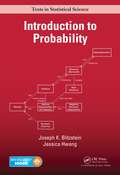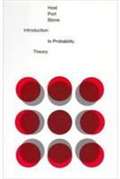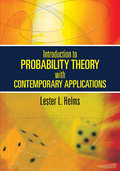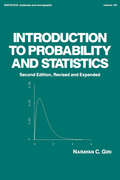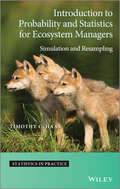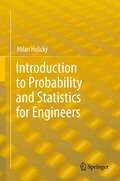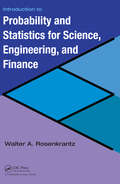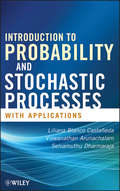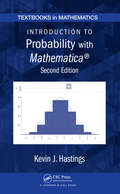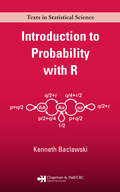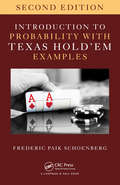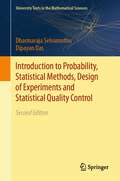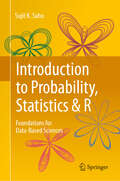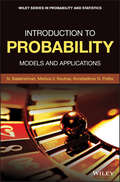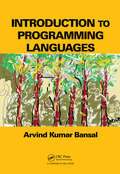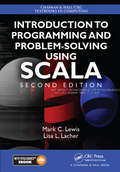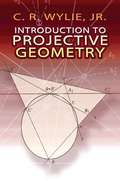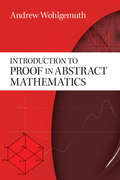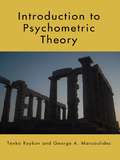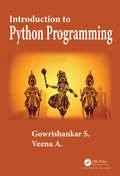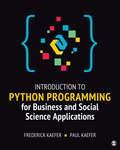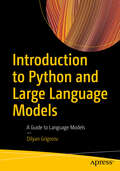- Table View
- List View
Introduction to Probability (Chapman And Hall/crc Texts In Statistical Science Ser. #112)
by Joseph K. BlitzsteinDeveloped from celebrated Harvard statistics lectures, Introduction to Probability provides essential language and tools for understanding statistics, randomness, and uncertainty. The book explores a wide variety of applications and examples, ranging from coincidences and paradoxes to Google PageRank and Markov chain Monte Carlo (MCMC). Additional
Introduction to Probability Theory
by Paul G. Hoel Sidney C. Port Charles J. StoneRandom Walks and Poisson Processes Combinatorial Analysis Discrete Random Variables Expectation of Discrete Random Variables Continuous Random Variables Jointly Distributed Random Variables Expectations and the Central Limit Theorem Moment Generating Functions and Characteristic Functions Probability Spaces
Introduction to Probability Theory with Contemporary Applications: With Contemporary Applications (Dover Books on Mathematics)
by Lester L. HelmsThis introduction to probability theory transforms a highly abstract subject into a series of coherent concepts. Its extensive discussions and clear examples, written in plain language, expose students to the rules and methods of probability. Suitable for an introductory probability course, this volume requires abstract and conceptual thinking skills and a background in calculus.Topics include classical probability, set theory, axioms, probability functions, random and independent random variables, expected values, and covariance and correlations. Additional subjects include stochastic processes, continuous random variables, expectation and conditional expectation, and continuous parameter Markov processes. Numerous exercises foster the development of problem-solving skills, and all problems feature step-by-step solutions
Introduction to Probability and Statistics (Statistics: A Series Of Textbooks And Monographs #136)
by Narayan C GiriBeginning with the historical background of probability theory, this thoroughly revised text examines all important aspects of mathematical probability - including random variables, probability distributions, characteristic and generating functions, stochatic convergence, and limit theorems - and provides an introduction to various types of statist
Introduction to Probability and Statistics for Ecosystem Managers: Simulation and Resampling (Statistics in Practice)
by Timothy C. HaasExplores computer-intensive probability and statistics for ecosystem management decision making Simulation is an accessible way to explain probability and stochastic model behavior to beginners. This book introduces probability and statistics to future and practicing ecosystem managers by providing a comprehensive treatment of these two areas. The author presents a self-contained introduction for individuals involved in monitoring, assessing, and managing ecosystems and features intuitive, simulation-based explanations of probabilistic and statistical concepts. Mathematical programming details are provided for estimating ecosystem model parameters with Minimum Distance, a robust and computer-intensive method. The majority of examples illustrate how probability and statistics can be applied to ecosystem management challenges. There are over 50 exercises – making this book suitable for a lecture course in a natural resource and/or wildlife management department, or as the main text in a program of self-study. Key features: Reviews different approaches to wildlife and ecosystem management and inference. Uses simulation as an accessible way to explain probability and stochastic model behavior to beginners. Covers material from basic probability through to hierarchical Bayesian models and spatial/ spatio-temporal statistical inference. Provides detailed instructions for using R, along with complete R programs to recreate the output of the many examples presented. Provides an introduction to Geographic Information Systems (GIS) along with examples from Quantum GIS, a free GIS software package. A companion website featuring all R code and data used throughout the book. Solutions to all exercises are presented along with an online intelligent tutoring system that supports readers who are using the book for self-study.
Introduction to Probability and Statistics for Engineers
by Milan HolickýThe theory of probability and mathematical statistics is becoming an indispensable discipline in many branches of science and engineering. This is caused by increasing significance of various uncertainties affecting performance of complex technological systems. Fundamental concepts and procedures used in analysis of these systems are often based on the theory of probability and mathematical statistics. The book sets out fundamental principles of the probability theory, supplemented by theoretical models of random variables, evaluation of experimental data, sampling theory, distribution updating and tests of statistical hypotheses. Basic concepts of Bayesian approach to probability and two-dimensional random variables, are also covered. Examples of reliability analysis and risk assessment of technological systems are used throughout the book to illustrate basic theoretical concepts and their applications. The primary audience for the book includes undergraduate and graduate students of science and engineering, scientific workers and engineers and specialists in the field of reliability analysis and risk assessment. Except basic knowledge of undergraduate mathematics no special prerequisite is required.
Introduction to Probability and Statistics for Science, Engineering, and Finance
by Walter A. RosenkrantzIntegrating interesting and widely used concepts of financial engineering into traditional statistics courses, Introduction to Probability and Statistics for Science, Engineering, and Finance illustrates the role and scope of statistics and probability in various fields.The text first introduces the basics needed to understand and create
Introduction to Probability and Stochastic Processes with Applications
by Liliana Blanco Castañeda Viswanathan Arunachalam Selvamuthu DharmarajaAn easily accessible, real-world approach to probability and stochastic processesIntroduction to Probability and Stochastic Processes with Applications presents a clear, easy-to-understand treatment of probability and stochastic processes, providing readers with a solid foundation they can build upon throughout their careers. With an emphasis on applications in engineering, applied sciences, business and finance, statistics, mathematics, and operations research, the book features numerous real-world examples that illustrate how random phenomena occur in nature and how to use probabilistic techniques to accurately model these phenomena.The authors discuss a broad range of topics, from the basic concepts of probability to advanced topics for further study, including Itô integrals, martingales, and sigma algebras. Additional topical coverage includes:Distributions of discrete and continuous random variables frequently used in applicationsRandom vectors, conditional probability, expectation, and multivariate normal distributionsThe laws of large numbers, limit theorems, and convergence of sequences of random variablesStochastic processes and related applications, particularly in queueing systemsFinancial mathematics, including pricing methods such as risk-neutral valuation and the Black-Scholes formulaExtensive appendices containing a review of the requisite mathematics and tables of standard distributions for use in applications are provided, and plentiful exercises, problems, and solutions are found throughout. Also, a related website features additional exercises with solutions and supplementary material for classroom use. Introduction to Probability and Stochastic Processes with Applications is an ideal book for probability courses at the upper-undergraduate level. The book is also a valuable reference for researchers and practitioners in the fields of engineering, operations research, and computer science who conduct data analysis to make decisions in their everyday work.
Introduction to Probability with Mathematica
by Kevin J. HastingsUpdated to conform to Mathematica® 7.0, Introduction to Probability with Mathematica®, Second Edition continues to show students how to easily create simulations from templates and solve problems using Mathematica. It provides a real understanding of probabilistic modeling and the analysis of data and encourages the application of these ideas to practical problems. The accompanyingdownloadable resources offer instructors the option of creating class notes, demonstrations, and projects.New to the Second Edition Expanded section on Markov chains that includes a study of absorbing chains New sections on order statistics, transformations of multivariate normal random variables, and Brownian motion More example data of the normal distribution More attention on conditional expectation, which has become significant in financial mathematics Additional problems from Actuarial Exam P New appendix that gives a basic introduction to Mathematica New examples, exercises, and data sets, particularly on the bivariate normal distribution New visualization and animation features from Mathematica 7.0 Updated Mathematica notebooks on the downloadable resources. After covering topics in discrete probability, the text presents a fairly standard treatment of common discrete distributions. It then transitions to continuous probability and continuous distributions, including normal, bivariate normal, gamma, and chi-square distributions. The author goes on to examine the history of probability, the laws of large numbers, and the central limit theorem. The final chapter explores stochastic processes and applications, ideal for students in operations research and finance.
Introduction to Probability with R (Chapman & Hall/CRC Texts in Statistical Science)
by Kenneth BaclawskiBased on a popular course taught by the late Gian-Carlo Rota of MIT, with many new topics covered as well, Introduction to Probability with R presents R programs and animations to provide an intuitive yet rigorous understanding of how to model natural phenomena from a probabilistic point of view. Although the R programs are small in length, they ar
Introduction to Probability with Statistical Applications
by Géza SchayNow inits second edition, this textbook serves as an introduction toprobability and statistics for non-mathematics majors who do not need theexhaustive detail and mathematical depth provided in more comprehensivetreatments of the subject. The presentation covers the mathematical laws ofrandom phenomena, including discrete and continuous random variables,expectation and variance, and common probability distributions such as thebinomial, Poisson, and normal distributions. More classical examples such asMontmort's problem, the ballot problem, and Bertrand's paradox are nowincluded, along with applications such as the Maxwell-Boltzmann andBose-Einstein distributions in physics. Keyfeatures in new edition: * 35 newexercises * Expanded sectionon the algebra of sets *Expanded chapters on probabilities to include more classical examples * Newsection on regression * Onlineinstructors' manual containing solutions to all exercises Advancedundergraduate and graduate students in computer science, engineering, and othernatural and social sciences with only a basic background in calculus willbenefit from this introductory text balancing theory with applications. Review of the first edition: This textbook is aclassical and well-written introduction to probability theory and statistics. . . . the book is written 'for an audience such as computer science students, whosemathematical background is not very strong and who do not need the detail andmathematical depth of similar books written for mathematics or statisticsmajors. ' . . . Each new concept is clearly explained and is followed by manydetailed examples. . . . numerous examples of calculations are given and proofs arewell-detailed. " (Sophie Lemaire, Mathematical Reviews, Issue 2008 m)
Introduction to Probability with Texas Hold’em Examples
by Frederic Paik SchoenbergIntroduction to Probability with Texas Hold’em Examples illustrates both standard and advanced probability topics using the popular poker game of Texas Hold’em, rather than the typical balls in urns. The author uses students’ natural interest in poker to teach important concepts in probability. This classroom-tested book covers the main subjects of a standard undergraduate probability course, including basic probability rules, standard models for describing collections of data, and the laws of large numbers. It also discusses several more advanced topics, such as the ballot theorem, the arcsine law, and random walks, as well as some specialized poker issues, such as the quantification of luck and skill in Texas Hold’em. Homework problems are provided at the end of each chapter. The author includes examples of actual hands of Texas Hold’em from the World Series of Poker and other major tournaments and televised games. He also explains how to use R to simulate Texas Hold’em tournaments for student projects. R functions for running the tournaments are freely available from CRAN (in a package called holdem). See Professor Schoenberg discuss the book.
Introduction to Probability, Second Edition (Chapman & Hall/CRC Texts in Statistical Science #112)
by Joseph K. Blitzstein Jessica HwangDeveloped from celebrated Harvard statistics lectures, Introduction to Probability provides essential language and tools for understanding statistics, randomness, and uncertainty. The book explores a wide variety of applications and examples, ranging from coincidences and paradoxes to Google PageRank and Markov chain Monte Carlo (MCMC). Additional application areas explored include genetics, medicine, computer science, and information theory. The authors present the material in an accessible style and motivate concepts using real-world examples. Throughout, they use stories to uncover connections between the fundamental distributions in statistics and conditioning to reduce complicated problems to manageable pieces.The book includes many intuitive explanations, diagrams, and practice problems. Each chapter ends with a section showing how to perform relevant simulations and calculations in R, a free statistical software environment. The second edition adds many new examples, exercises, and explanations, to deepen understanding of the ideas, clarify subtle concepts, and respond to feedback from many students and readers. New supplementary online resources have been developed, including animations and interactive visualizations, and the book has been updated to dovetail with these resources. Supplementary material is available on Joseph Blitzstein’s website www. stat110.net. The supplements include:Solutions to selected exercisesAdditional practice problemsHandouts including review material and sample exams Animations and interactive visualizations created in connection with the edX online version of Stat 110.Links to lecture videos available on ITunes U and YouTube There is also a complete instructor's solutions manual available to instructors who require the book for a course.
Introduction to Probability, Statistical Methods, Design of Experiments and Statistical Quality Control (University Texts in the Mathematical Sciences)
by Dharmaraja Selvamuthu Dipayan DasThis revised book provides an accessible presentation of concepts from probability theory, statistical methods, the design of experiments, and statistical quality control. It is shaped by the experience of the two teachers teaching statistical methods and concepts to engineering students. Practical examples and end-of-chapter exercises are the highlights of the text, as they are purposely selected from different fields. Statistical principles discussed in the book have a great relevance in several disciplines like economics, commerce, engineering, medicine, health care, agriculture, biochemistry, and textiles to mention a few.Organised into 16 chapters, the revised book discusses four major topics—probability theory, statistical methods, the design of experiments, and statistical quality control. A large number of students with varied disciplinary backgrounds need a course in basics of statistics, the design of experiments and statistical quality control at an introductory level to pursue their discipline of interest. No previous knowledge of probability or statistics is assumed, but an understanding of calculus is a prerequisite. The whole book also serves as a master level introductory course in all the three topics, as required in textile engineering or industrial engineering.
Introduction to Probability, Statistics & R: Foundations for Data-Based Sciences
by Sujit K. SahuA strong grasp of elementary statistics and probability, along with basic skills in using R, is essential for various scientific disciplines reliant on data analysis. This book serves as a gateway to learning statistical methods from scratch, assuming a solid background in high school mathematics. Readers gradually progress from basic concepts to advanced statistical modelling, with examples from actuarial, biological, ecological, engineering, environmental, medicine, and social sciences highlighting the real-world relevance of the subject. An accompanying R package enables seamless practice and immediate application, making it ideal for beginners. The book comprises 19 chapters divided into five parts. Part I introduces basic statistics and the R software package, teaching readers to calculate simple statistics and create basic data graphs. Part II delves into probability concepts, including rules and conditional probability, and introduces widelyused discrete and continuous probability distributions (e.g., binomial, Poisson, normal, log-normal). It concludes with the central limit theorem and joint distributions for multiple random variables. Part III explores statistical inference, covering point and interval estimation, hypothesis testing, and Bayesian inference. This part is intentionally less technical, making it accessible to readers without an extensive mathematical background. Part IV addresses advanced probability and statistical distribution theory, assuming some familiarity with (or concurrent study of) mathematical methods like advanced calculus and linear algebra. Finally, Part V focuses on advanced statistical modelling using simple and multiple regression and analysis of variance, laying the foundation for further studies in machine learning and data science applicable to various data and decision analytics contexts. Based on years of teaching experience, this textbook includes numerousexercises and makes extensive use of R, making it ideal for year-long data science modules and courses. In addition to university courses, the book amply covers the syllabus for the Actuarial Statistics 1 examination of the Institute and Faculty of Actuaries in London. It also provides a solid foundation for postgraduate studies in statistics and probability, or a reliable reference for statistics.
Introduction to Probability: Models and Applications (Wiley Series in Probability and Statistics)
by N. Balakrishnan Markos V. Koutras Konstadinos G. PolitisAn essential guide to the concepts of probability theory that puts the focus on models and applications Introduction to Probability offers an authoritative text that presents the main ideas and concepts, as well as the theoretical background, models, and applications of probability. The authors—noted experts in the field—include a review of problems where probabilistic models naturally arise, discuss the appropriate statistical methods, and explain how these models fit into the data presented. To aid in understanding, the book presents many real-world exercises and solutions that appear after each section within a chapter. A wide-range of topics are covered that include concepts of probability, univariate discrete distribution, univariate continuous distributions, bivariate discrete random variables, bivariate continuous random variables, stochastic independence-multivariate random variables, and many more. Designed as a useful guide, the text contains theory of probability, definitions, charts, examples, illustrations, problems and solutions, and a glossary. This important text: Includes classroom-tested problems and solutions to probability exercises Highlights real-world exercises designed to make clear the concepts presented Uses Matlab software to illustrate the text’s computer exercises Features applications representing worldwide situations and processes Offers a Student Solutions Manual that contains select solutions to numerous exercises found in the book Written for students majoring in statistics, engineering, operations research, computer science, physics, and mathematics, Introduction to Probability: Models and Applications is an accessible text that explores the basic concepts of probability and includes detailed information on models and applications.
Introduction to Programming Languages
by Arvind Kumar BansalIn programming courses, using the different syntax of multiple languages, such as C++, Java, PHP, and Python, for the same abstraction often confuses students new to computer science. Introduction to Programming Languages separates programming language concepts from the restraints of multiple language syntax by discussing the concepts at an abstrac
Introduction to Programming and Problem-Solving Using Scala (Chapman & Hall/CRC Textbooks in Computing)
by Mark C. Lewis Lisa LacherPraise for the first edition: "The well-written, comprehensive book…[is] aiming to become a de facto reference for the language and its features and capabilities. The pace is appropriate for beginners; programming concepts are introduced progressively through a range of examples and then used as tools for building applications in various domains, including sophisticated data structures and algorithms…Highly recommended. Students of all levels, faculty, and professionals/practitioners.—D. Papamichail, University of Miami in CHOICE Magazine Mark Lewis’ Introduction to the Art of Programming Using Scala was the first textbook to use Scala for introductory CS courses. Fully revised and expanded, the new edition of this popular text has been divided into two books. Introduction to Programming and Problem-Solving Using Scala is designed to be used in first semester college classrooms to teach students beginning programming with Scala. The book focuses on the key topics students need to know in an introductory course, while also highlighting the features that make Scala a great programming language to learn. The book is filled with end-of-chapter projects and exercises, and the authors have also posted a number of different supplements on the book website. Video lectures for each chapter in the book are also available on YouTube. The videos show construction of code from the ground up and this type of "live coding" is invaluable for learning to program, as it allows students into the mind of a more experienced programmer, where they can see the thought processes associated with the development of the code. About the Authors Mark Lewis is a Professor at Trinity University. He teaches a number of different courses, spanning from first semester introductory courses to advanced seminars. His research interests included simulations and modeling, programming languages, and numerical modeling of rings around planets with nearby moons. Lisa Lacher is an Assistant Professor at the University of Houston, Clear Lake with over 25 years of professional software development experience. She teaches a number of different courses spanning from first semester introductory courses to graduate level courses. Her research interests include Computer Science Education, Agile Software Development, Human Computer Interaction and Usability Engineering, as well as Measurement and Empirical Software Engineering.
Introduction to Projective Geometry
by C. R. Wylie Jr.This lucid introductory text offers both an analytic and an axiomatic approach to plane projective geometry. The analytic treatment builds and expands upon students' familiarity with elementary plane analytic geometry and provides a well-motivated approach to projective geometry. Subsequent chapters explore Euclidean and non-Euclidean geometry as specializations of the projective plane, revealing the existence of an infinite number of geometries, each Euclidean in nature but characterized by a different set of distance- and angle-measurement formulas. Outstanding pedagogical features include worked-through examples, introductions and summaries for each topic, and numerous theorems, proofs, and exercises that reinforce each chapter's precepts. Two helpful indexes conclude the text, along with answers to all odd-numbered exercises. In addition to its value to undergraduate students of mathematics, computer science, and secondary mathematics education, this volume provides an excellent reference for computer science professionals.
Introduction to Proof in Abstract Mathematics
by Andrew WohlgemuthThe primary purpose of this undergraduate text is to teach students to do mathematical proofs. It enables readers to recognize the elements that constitute an acceptable proof, and it develops their ability to do proofs of routine problems as well as those requiring creative insights. The self-contained treatment features many exercises, problems, and selected answers, including worked-out solutions. Starting with sets and rules of inference, this text covers functions, relations, operation, and the integers. Additional topics include proofs in analysis, cardinality, and groups. Six appendixes offer supplemental material. Teachers will welcome the return of this long-out-of-print volume, appropriate for both one- and two-semester courses.
Introduction to Psychometric Theory
by George A. Marcoulides Tenko RaykovThis new text provides a state-of the-art introduction to educational and psychological testing and measurement theory that reflects many intellectual developments of the past two decades. The book introduces psychometric theory using a latent variable modeling (LVM) framework and emphasizes interval estimation throughout, so as to better prepare readers for studying more advanced topics later in their careers. Featuring numerous examples, it presents an applied approach to conducting testing and measurement in the behavioral, social, and educational sciences. Readers will find numerous tips on how to use test theory in today's actual testing situations. To reflect the growing use of statistical software in psychometrics, the authors introduce the use of Mplus after the first few chapters. IBM SPSS, SAS, and R are also featured in several chapters. Software codes and associated outputs are reviewed throughout to enhance comprehension. Essentially all of the data used in the book are available on the website. In addition instructors will find helpful PowerPoint lecture slides and questions and problems for each chapter. The authors rely on LVM when discussing fundamental concepts such as exploratory and confirmatory factor analysis, test theory, generalizability theory, reliability and validity, interval estimation, nonlinear factor analysis, generalized linear modeling, and item response theory. The varied applications make this book a valuable tool for those in the behavioral, social, educational, and biomedical disciplines, as well as in business, economics, and marketing. A brief introduction to R is also provided. Intended as a text for advanced undergraduate and/or graduate courses in psychometrics, testing and measurement, measurement theory, psychological testing, and/or educational and/or psychological measurement taught in departments of psychology, education, human development, epidemiology, business, and marketing, it will also appeal to researchers in these disciplines. Prerequisites include an introduction to statistics with exposure to regression analysis and ANOVA. Familiarity with SPSS, SAS, STATA, or R is also beneficial. As a whole, the book provides an invaluable introduction to measurement and test theory to those with limited or no familiarity with the mathematical and statistical procedures involved in measurement and testing.
Introduction to Python Programming
by Gowrishankar S Veena AIntroduction to Python Programming is written for students who are beginners in the field of computer programming. This book presents an intuitive approach to the concepts of Python Programming for students. This book differs from traditional texts not only in its philosophy but also in its overall focus, level of activities, development of topics, and attention to programming details. The contents of the book are chosen with utmost care after analyzing the syllabus for Python course prescribed by various top universities in USA, Europe, and Asia. Since the prerequisite know-how varies significantly from student to student, the book’s overall overture addresses the challenges of teaching and learning of students which is fine-tuned by the authors’ experience with large sections of students. This book uses natural language expressions instead of the traditional shortened words of the programming world. This book has been written with the goal to provide students with a textbook that can be easily understood and to make a connection between what students are learning and how they may apply that knowledge. <P><P> Features of this book <P><P> This book does not assume any previous programming experience, although of course, any exposure to other programming languages is useful <P><P> This book introduces all of the key concepts of Python programming language with helpful illustrations <P><P> Programming examples are presented in a clear and consistent manner <P><P> Each line of code is numbered and explained in detail <P><P> Use of f-strings throughout the book <P><P> Hundreds of real-world examples are included and they come from fields such as entertainment, sports, music and environmental studies <P><P> Students can periodically check their progress with in-chapter quizzes that appear in all chapters
Introduction to Python Programming for Business and Social Science Applications
by Paul Kaefer Frederick KaeferWould you like to gather big datasets, analyze them, and visualize the results, all in one program? If this describes you, then Introduction to Python Programming for Business and Social Science Applications is the book for you. Authors Frederick Kaefer and Paul Kaefer walk you through each step of the Python package installation and analysis process, with frequent exercises throughout so you can immediately try out the functions you’ve learned. Written in straightforward language for those with no programming background, this book will teach you how to use Python for your research and data analysis. Instead of teaching you the principles and practices of programming as a whole, this application-oriented text focuses on only what you need to know to research and answer social science questions. The text features two types of examples, one set from the General Social Survey and one set from a large taxi trip dataset from a major metropolitan area, to help readers understand the possibilities of working with Python. Chapters on installing and working within a programming environment, basic skills, and necessary commands will get you up and running quickly, while chapters on programming logic, data input and output, and data frames help you establish the basic framework for conducting analyses. Further chapters on web scraping, statistical analysis, machine learning, and data visualization help you apply your skills to your research. More advanced information on developing graphical user interfaces (GUIs) help you create functional data products using Python to inform general users of data who don’t work within Python. First there was IBM® SPSS®, then there was R, and now there′s Python. Statistical software is getting more aggressive - let authors Frederick Kaefer and Paul Kaefer help you tame it with Introduction to Python Programming for Business and Social Science Applications.
Introduction to Python Programming for Business and Social Science Applications
by Paul Kaefer Frederick KaeferWould you like to gather big datasets, analyze them, and visualize the results, all in one program? If this describes you, then Introduction to Python Programming for Business and Social Science Applications is the book for you. Authors Frederick Kaefer and Paul Kaefer walk you through each step of the Python package installation and analysis process, with frequent exercises throughout so you can immediately try out the functions you’ve learned. Written in straightforward language for those with no programming background, this book will teach you how to use Python for your research and data analysis. Instead of teaching you the principles and practices of programming as a whole, this application-oriented text focuses on only what you need to know to research and answer social science questions. The text features two types of examples, one set from the General Social Survey and one set from a large taxi trip dataset from a major metropolitan area, to help readers understand the possibilities of working with Python. Chapters on installing and working within a programming environment, basic skills, and necessary commands will get you up and running quickly, while chapters on programming logic, data input and output, and data frames help you establish the basic framework for conducting analyses. Further chapters on web scraping, statistical analysis, machine learning, and data visualization help you apply your skills to your research. More advanced information on developing graphical user interfaces (GUIs) help you create functional data products using Python to inform general users of data who don’t work within Python. First there was IBM® SPSS®, then there was R, and now there′s Python. Statistical software is getting more aggressive - let authors Frederick Kaefer and Paul Kaefer help you tame it with Introduction to Python Programming for Business and Social Science Applications.
Introduction to Python and Large Language Models: A Guide to Language Models
by Dilyan GrigorovGain a solid foundation for Natural Language Processing (NLP) and Large Language Models (LLMs), emphasizing their significance in today’s computational world. This book is an introductory guide to NLP and LLMs with Python programming. The book starts with the basics of NLP and LLMs. It covers essential NLP concepts, such as text preprocessing, feature engineering, and sentiment analysis using Python. The book offers insights into Python programming, covering syntax, data types, conditionals, loops, functions, and object-oriented programming. Next, it delves deeper into LLMs, unraveling their complex components. You’ll learn about LLM elements, including embedding layers, feedforward layers, recurrent layers, and attention mechanisms. You’ll also explore important topics like tokens, token distributions, zero-shot learning, LLM hallucinations, and insights into popular LLM architectures such as GPT-4, BERT, T5, PALM, and others. Additionally, it covers Python libraries like Hugging Face, OpenAI API, and Cohere. The final chapter bridges theory with practical application, offering step-by-step examples of coded applications for tasks like text generation, summarization, language translation, question-answering systems, and chatbots. In the end, this book will equip you with the knowledge and tools to navigate the dynamic landscape of NLP and LLMs. What You’ll Learn Understand the basics of Python and the features of Python 3.11 Explore the essentials of NLP and how do they lay the foundations for LLMs. Review LLM components. Develop basic apps using LLMs and Python. Who This Book Is For Data analysts, AI and Machine Learning Experts, Python developers, and Software Development Professionals interested in learning the foundations of NLP, LLMs, and the processes of building modern LLM applications for various tasks.
